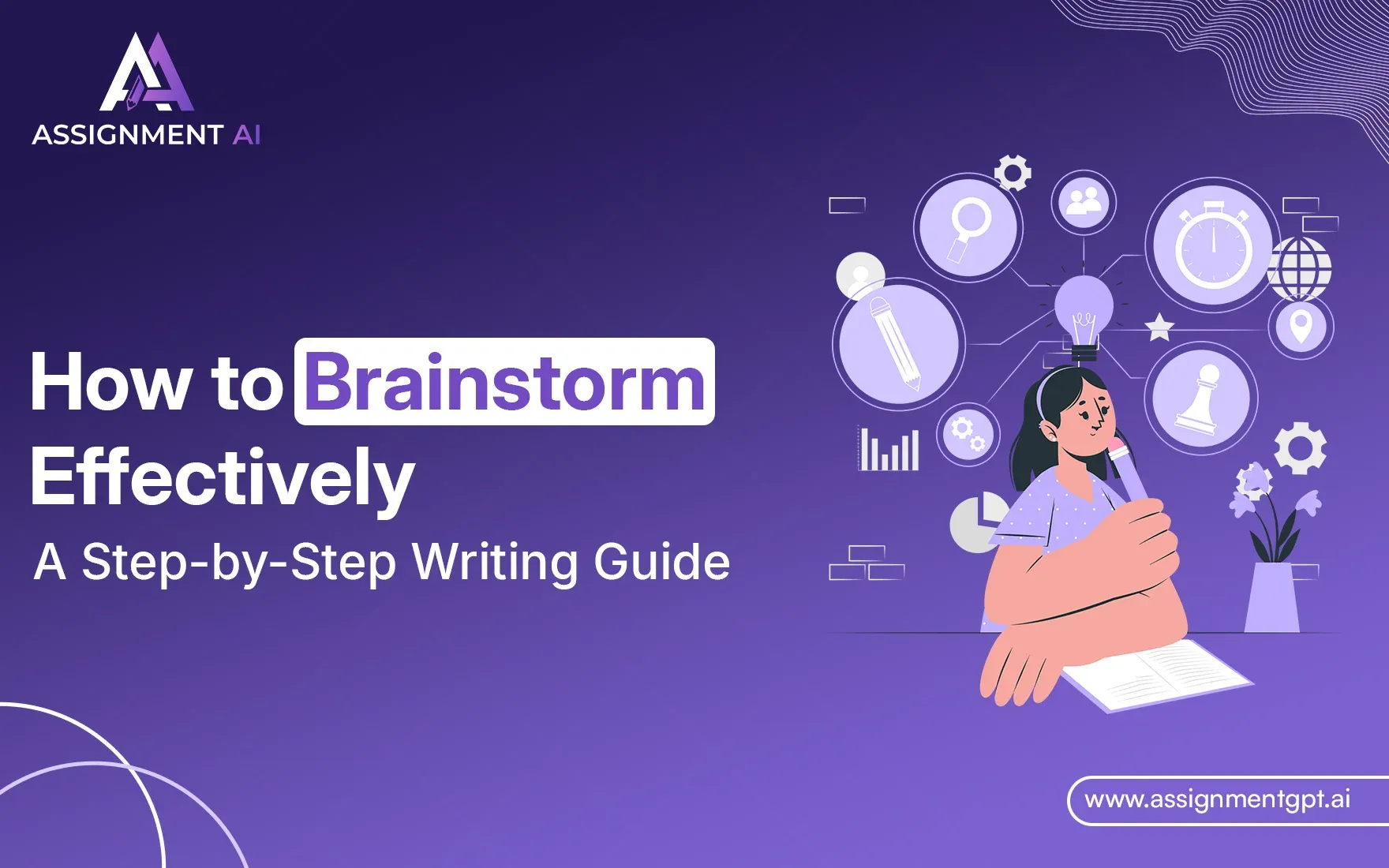AssignmentGPT Blogs
Has it ever happened to you that you are holding a pen and paper and thinking about how to start your content? Even if you have a topic available, you still don’t have the exact idea of how to make the content interesting. And you are not the only one who faces this problem; many content writers like me face this problem daily.
I write a lot of professional content for businesses, academic purposes, and creative projects daily, so I noticed that brainstorming isn’t just helpful; it’s essential.
In the last few years, I have tested many brainstorming techniques, which include making sticky notes to using advanced AI tools.
So, whether you are a student, content creator or a professional, in this article I will guide you in detail on how you can organise your ideas and use them effectively in your writing.
Quick Summary
If we understand brainstorming in simple language, then it is the process of generating, organising, and refining ideas to solve a problem or complete a writing task. And when you do it in the right way, then it helps you a lot in writing faster and also in thinking about your topic in a deeper way, so that you can communicate effectively with the readers in your writing.
Our Focus in this Article:
- What is Brainstorming? How can you use it effectively in your writing?
- What benefits will you get by doing Brainstorming?
- And I will try to guide you from experience as, how you can use the best techniques of brainstorming in your writing.
- And at the end of the article, we will discuss the common mistakes of brainstorming, and if you are a beginner, then do not skip this part at all.
What is Brainstorming?
Brainstorming helps you capture your raw thoughts, and if used effectively, you will get a finished piece of your writing. It does not mean that you have to choose the perfect sentence or paragraph; it means that you have to create the best writing tone and structure for the content in your mind.
In my own writing practice, I try to brainstorm on different topics, and it is like a mental warm-up for me. It helps me to know how my mind works on a particular topic and what knowledge I have, and how I can further sharpen my mind on contextual topics. Whether you brainstorm using paper, sticky notes, or tools, what matters is that it feels like a new idea to you in some way.
Why is Brainstorming Important?
You can think of brainstorming as the first step to outlining, because writing without brainstorming is like starting to build a house without a blueprint. Without planning, you increase the chances of having a major issue, or you won't be able to prepare your content at a consistent pace.
Brainstorming helps:
1. Clarify your message: Before writing, do a thorough research on your topic and then figure out how you want to convey your content and what the theme of your writing is.
2. Save time: If you brainstorm all parts of your content beforehand, it will give you an effective outlining that will help you write smoothly and will also save you a lot of time.
3. Unlock creativity: When you write with thinking and planning, you can add your creativity to it, and due to brainstorming, you are capable of creating hookable content.
4. Reduce anxiety: After starting to write the content, you will not have to think again and again about what line to write next. By brainstorming, you already have a clear path available due to you do not have to wait for the perfect idea.
How to Prepare for Brainstorming
Let me tell you how I brainstorm while writing my professional content so that I get a proper roadmap for my content in advance.
1. Choose Your Topic and Goal
Before brainstorming, you have to decide on your goal, because if the content is not interesting enough, or if it does not follow the goal, then there is no use in such content. So first of all, define what problem you are writing to solve, whether it is a blog, a college essay or its format, so that you can brainstorm in a dedicated way.
Ask yourself:
- What is my end objective?
- Who is my audience?
- What’s the one thing I want them to take away?
2. Set the Right Environment
Whenever you’re outlining or thinking of an idea for your content, try to keep the space free of distractions, and then close unnecessary tabs, put your phone on silent, and create a peaceful environment for yourself so that you can brainstorm well.
3. Decide: Solo or Group?
Mostly, I brainstorm solo on simple topics and use Grammarly, ChatGPT, and Google Docs for this, but sometimes, for creative work, I invite my teammates to a group meeting so that we can discuss many ideas together.
4. Set a Time Limit
Brainstorming does not mean that you waste 1-2 days only on this and then on outlining, so it is very important that you set a timeline so that you can complete your content in a time frame. This will reduce your pressure, and your productivity will also be high.
Also read this article : Mastering the Art of Outlining
Some Popular Brainstorming Techniques
Let's learn about some popular techniques of brainstorming, which are mostly used by professionals.
1. Freewriting
Sometimes it is not good to be too rigid, so if you don't get an idea, just start writing without any judgment, and write freely for 5-10 minutes. This will clear your mental clutter, and you will also get a good idea.
2. Mind Mapping
If your article is quite lengthy or creative, then you can use mind maps in the outlining process; this is perfect for visual thinkers. For this, keep your main topic in the centre of your mind map, after that create branches and sub-ideas related to it.
3. Listing / Bullet Points
Use listings or bullet points in your content. These are perfect for linear thinkers. For this, you write down your thoughts. I use this technique a lot for outlining, listing and content introduction of my articles.
4. Who? What? When? Where? Why? How?
This technique helps me explore a topic deeply and find new angles. It’s especially helpful for writing product reviews or storytelling. This gives me a lot of detailed ideas of how to do the introduction and story building of my article. For this, you can figure out a heading with different scenarios.
5. Clustering / Webbing
Mindmaps are quite simple, but still writing your thoughts on one page at a time feels quite cluttered, but this way you can use your best thoughts for your content.
6. Cubing
In this, you describe your ideas and accordingly compare, associate, analyze with different thoughts and use them for writing. With this technique, you can write your content from six sides.
Key Steps to Brainstorm for Writing
Let’s learn the step-by-step process that I follow for brainstorming my writing.
Step 1: Define Your Writing Goal or Problem
Be very clear in your writing and ask yourself once whether your writing informs, persuades, entertains, or instructs.
Example:
- Bad: I want to write about productivity.
- Good: I want to help freelancers manage their time using AI tools.
Step 2: Choose a Brainstorming Method
It is not necessary that you use all brainstorming techniques; you can also pick the technique that suits you and start.
Tip: Mix and match methods. I often start with freewriting, then switch to mapping. And after this, I do the final outlining.
Step 3: Generate Ideas Without Filtering Them
Sometimes revising again and again can also disrupt the ideas, so instead of editing again and again, it is better to just write, not judge.
Because sometimes even bad ideas give good ideas. For this, I use a digital timer. Whatever ideas come to me in a fixed time, I then decide from them which ideas can be perfect for me.
Step 4: Group and Refine Your Ideas
After brainstorming, you refine your thoughts further, and for this, you highlight your ideas so that you can give priority to better ideas.
For this, I often categorize my raw brainstorming ideas into a document and then use the good ideas.
Step 5: Create an Outline or Plan
This is the most important thing. Once you decide on an idea, you convert it into a real structure, and for this, outlining is best.
In this, you note the hook and context of your introduction and then note the main points and conclusion.
Generally, I use colour-coded highlights to organize this. And if you prefer digital tools, Grammarly or Notion can be great for building outlines.
Tips for Effective Brainstorming
Let’s know about some effective tips for Brainstorming, which I also follow.
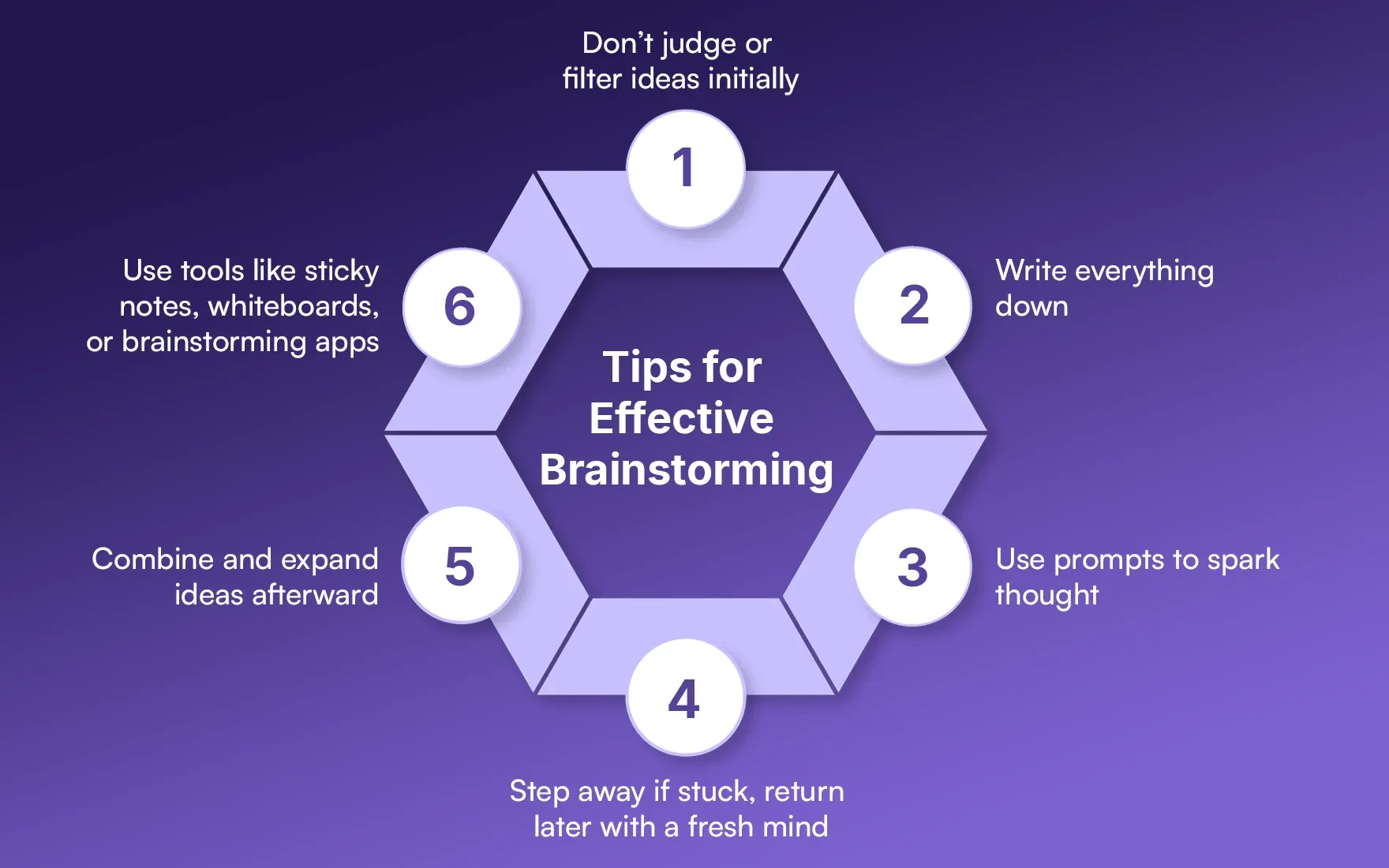
1. Don’t judge or filter ideas initially: Since you cannot do editing after brainstorming, do not judge and filter your thoughts and ideas initially.
2. Write everything down: Always try to note down all your thoughts and ideas for specific writing, even if your thoughts are weird.
3. Use prompts or AI tools: Use tools like Grammarly’s AI or ChatGPT, which help you with ideas and copywriting.
4. Take a break if stuck: Whenever you are unable to think of any idea, take a 5-minute walk in a distraction-free environment. This will refresh your mind.
5. Combine and expand: While brainstorming, merge small ideas into bigger concepts. This will give you a clear path for your writing.
6. Use physical/digital tools: I also use sticky notes, whiteboards, and mind maps in my writing process. So, you should definitely do whatever makes sense to you, even if you don’t have to write your ideas on paper.
Read More : 6 Common Types of Writing Outlines With Examples & Use Cases
Turning Ideas into Actionable Content
When you have done brainstorming, you finally know what you have to do after that:
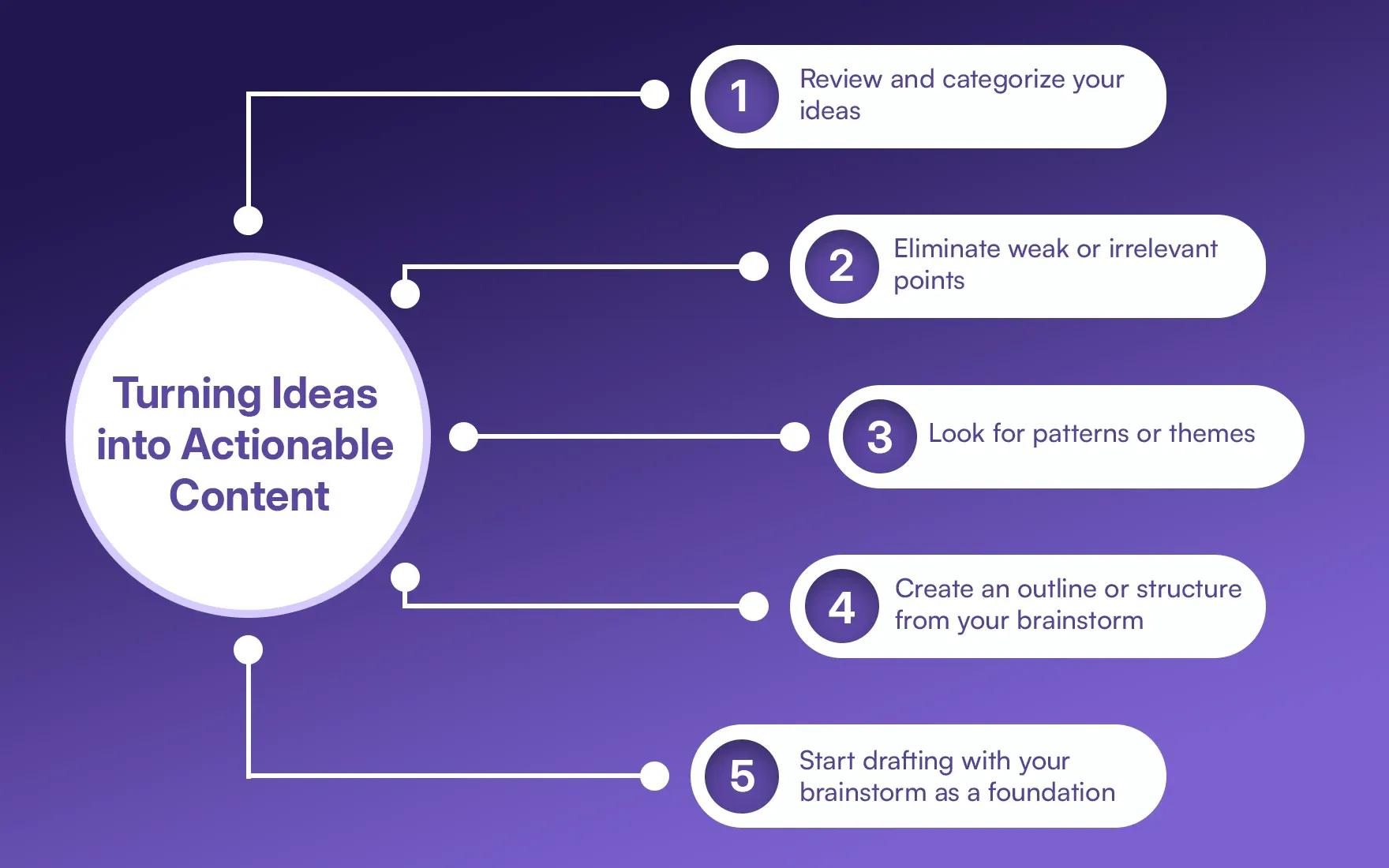
1. Review and categorize ideas: If you feel that any of your writing data is outdated, then update it with new information and check whether any paragraph or theme is repeating or not.
2. Eliminate weak points: In the final brainstorming, when you check the manual, replace all the out-of-context ideas or weak points of writing with good ideas, so that your content is the best out of the best.
3. Spot patterns: Always make sure that your writing structure is good and follows a logical flow, so that your content is unique and engaging.
4. Create a rough outline: Always use proper outlining and drafting for better writing; this will save you from thinking again and again about what to write in the next line.
5. Start drafting: In the beginning, no one can do perfect brainstorming, in fact, I also could not do it, so it is important that you note down your thoughts and use them, do not wait for it to be perfect.
Pro Tip: Never get frustrated with revising the brainstorming draft, because the more times you revise, the better your outlining and idea narration will be.
Common Mistakes to Avoid for Brainstorming
Even after doing content writing for so many years, sometimes I make mistakes myself, and you will get to learn a lot from my mistakes. Let’s know about it.
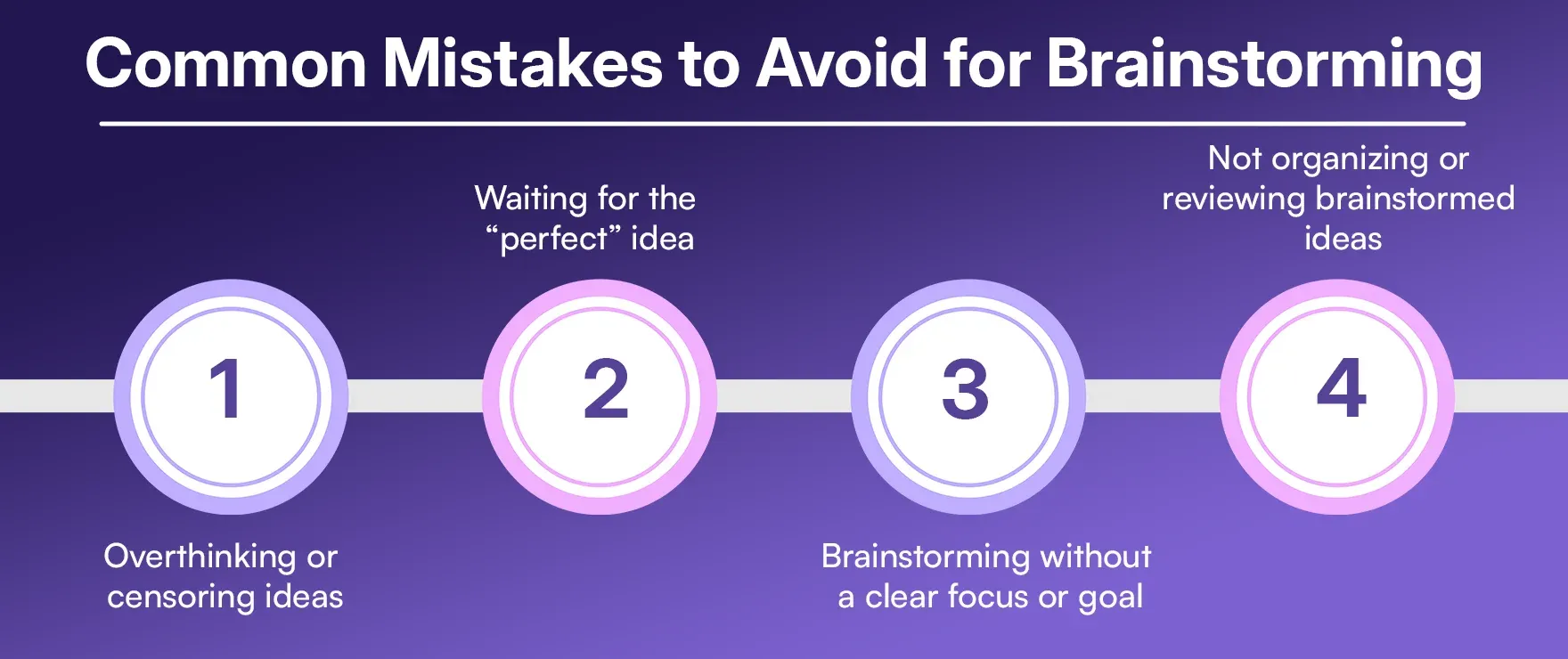
1. Overthinking: Initially, all writers think that they have to keep their content perfect, and for this, they do over brainstorming, which does not benefit them much but only increases overthinking. Because brainstorming increases with time and experience, not instantly.
2. Waiting for the perfect idea: There is never a perfect timing for any work; similarly, when you are outlining for writing, do not wait for the perfect idea. In such a situation, just refine your content, and it will make your content engaging.
3. No clear focus: If you repeatedly write unrelated thoughts, the quality of your brainstorming will not be that good and filtering out the ideas will also take a lot of time.
4. Not organizing ideas: You can consider brainstorming as half art, structure, outlining, and writing skills also matter a lot, and you will get all these things through experience. As you practice them, you will become more and more perfect in them.
Conclusion
So, whether you want to write an essay, article or video script, it is very important for better writing that you use effective brainstorming, as it will improve your writing a lot. This will give shape to your thoughts, which you will be able to sharpen with your creativity. And you can make it even better by using the tools of assignmentGPT AI in your brainstorming.
My Recommendation: Initially, you should start brainstorming with a clear goal and then choose the right technique, and let your ideas flow freely. Refine your thoughts further. And the most important thing is that you should practice it a lot because experience, outlining knowledge, and writing skills are also very important for better brainstorming.
FAQs
1. What’s the best way to start brainstorming when stuck?
2. How long should a brainstorming session last?
3. What if I have too many ideas?
4. Is group brainstorming better than solo?
5. Can AI tools really help?
6. Why is brainstorming important?
7. What are some effective brainstorming techniques?
8. How do I ensure a brainstorming session is productive?
Content writer at @AssignmentGPT
Rashi Sharma is a content writer who helps brands put their thoughts into words. She creates blogs, website content, and brand stories that are easy to understand and feel genuine. Her writing style focuses on keeping things clear and making sure the message connects with the right people.
Master AI with
AssignmentGPT!
Get exclusive access to insider AI stories, tips and tricks. Sign up to the newsletter and be in the know!
Transform Your Studies with the Power of AssignmentGPT
Empower your academic pursuits with tools to enhance your learning speed and optimize your productivity, enabling you to excel in your studies with greater ease.
Start Your Free Trial ➤Start your success story with Assignment GPT! 🌟 Let's soar! 🚀
Step into the future of writing with our AI-powered platform. Start your free trial today and revolutionize your productivity, saving over 20 hours weekly.
Try For FREE ➤


